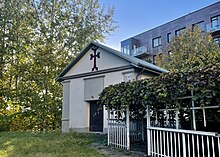Armenians in Lithuania
 Saint Vardan Armenian church in Vilnius | |
| Total population | |
|---|---|
| 1477[1]-2500 | |
| Regions with significant populations | |
| Vilnius, Klaipėda | |
| Languages | |
| Armenian, Lithuanian, Russian | |
| Religion | |
| Armenian Apostolic Church | |
| Related ethnic groups | |
| Armenian diaspora |
Armenians in Lithuania (Armenian: Հայերը Լիտվայում, romanized: Hayery Litvayum) refers to ethnic Armenians living in Lithuania.
According to the Lithuanian census of 2011 there were 1,233[2] Armenians in Lithuania. Armenian organizations put the number around 2,500.[3] According to Soviet 1989 census there are 1,655 Armenians in Lithuania.[4] The Armenians live mainly in Vilnius.
History
[edit]In the Late Middle Ages, Armenians inhabited the cities of Kyiv, Włodzimierz, Krzemieniec and Łuck in the southern part of the Grand Duchy of Lithuania.[5] First Armenians in Vilnius were noted in 1501.[6] Armenians from Kyiv served as translators of Lithuanian envoys to the Tatar khans in the 16th century.[7] After the main centers of Armenians in Lithuania passed to Poland within the Polish–Lithuanian Commonwealth, the settlement of Armenians in Lithuania was of an episodic nature and was due mainly to the needs of trade, although from the historical sources it is known, that Armenian school was established in 16th century Vilnius, Armenian guild in the 16th to 18th centuries Vilnius.[8] One of the most prominent painter of the 19th century in Lithuania was Jan Rustem (Armenian: Յան Ռուստամ).
Demographics
[edit]The roots of the Armenian community now living in Lithuania traces back to migration occurring in the 20th century.
| census 19591 | census 19702 | census 19793 | census 19894 | census 20015 | census 20115 | |||||||
|---|---|---|---|---|---|---|---|---|---|---|---|---|
| Number | % | Number | % | Number | % | Number | % | Number | % | Number | % | |
| 471 | 0.02 | 508 | 0.02 | 955 | 0.03 | 1,655 | 0.04 | 1,477 | 0.04 | 1,233 | 0.04 | |
| 1 Source: [3]. 2 Source: [4]. 3 Source: [5]. 4 Source: [6]. 5 Source: [7]. | ||||||||||||
Community members estimated their count at 2500 in 2001.[9]
Recent developments
[edit]An Armenian community center was opened in year 2000.[9]
A Khachkar was erected in the Hill of crosses in 2001 and in the center of Kaunas in 2004.
An Armenian church, St. Vardan, was opened in Vilnius in 2006.[10][11]
In 2011, the Armenian Embassy in Lithuania was opened.[12] Updates on Armenian cultural events in Lithuania can be found on the twitter page of the Armenian Ambassador to Lithuania.[13][14]
Famous Lithuanian Armenians
[edit]- Seržas Gandžumianas, a famous designer
- Marat Sargsyan, a TV host and film-maker
See also
[edit]References
[edit]- ^ "Population by ethnicity (2001 Census)". Department of Statistics to the Government of the Republic of Lithuania (Statistics Lithuania), 2005. Archived from the original on 2009-05-05. Retrieved 2009-11-14.
- ^ "2011 Census Results". Department of Statistics to the Government of the Republic of Lithuania (Statistics Lithuania), 2012. Archived from the original on 2012-10-05. Retrieved 2012-09-30.
- ^ ArmenianDiaspora website Archived May 11, 2013, at the Wayback Machine
- ^ Демоскоп Weekly - Всесоюзная перепись населения 1989 года.Национальный состав населения по республикам СССР
- ^ Stopka 2000, p. 26.
- ^ Stopka 2000, p. 120.
- ^ Stopka 2000, p. 57.
- ^ [1] History of Armenians in Lithuania (in Lithuanian)
- ^ a b "THE ARMENIANS OF LITHUANIA: THE CHALLENGE OF LIFE IN THE NEW DIASPORA". AGBU | Armenian non-profit organization. Retrieved 2018-04-14.
- ^ [2] Archived 2012-11-14 at the Wayback Machine (in Lithuanian)
- ^ davkstudio (2017-02-01), St. Vardan's Armenian apostolic church in Vilnius 2017, retrieved 2018-04-14
- ^ "The Armenian Embassy was opened in Vilnius - Press Releases - Ministry of Foreign Affairs of Armenia". www.mfa.am. Archived from the original on 2018-04-14. Retrieved 2018-04-14.
- ^ "Tigran Mkrtchyan (@TMkrtchyan) | Twitter". twitter.com. Retrieved 2018-04-14.
- ^ "Embassy of Armenia in Lithuania, Latvia, Estonia (@armemblit) | Twitter". twitter.com. Retrieved 2018-04-14.
Bibliography
[edit]- Stopka, Krzysztof (2000). Ormianie w Polsce dawnej i dzisiejszej (in Polish). Kraków: Księgarnia Akademicka. ISBN 83-7188-325-0.

